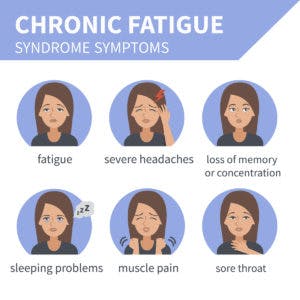Chronic fatigue syndrome (CFS) results in persistent medically unexplained fatigue. For the diagnosis to be made symptoms are present for at least 6 months. Sufferers experience significant disability and distress that is made worse by a lack of understanding from others, including medical professionals.
No specific cause for CFS has been identified. There is some evidence that viral infection and stress are triggers. There is also evidence of changes in the immune, nervous and hormonal systems. It is likely that different factors apply to different people with the condition.
If you suffer from CFS, you are probably fearful to implement an exercise program. You may fear an exacerbation of fatigue after attempting to exercise. This is certainly understandable. People with CFS respond differently to the stresses of physical exercise. Therefore, a non-traditional exercise approach is needed. Thankfully, there is new research proving the benefits of physical therapist-guided exercise in people with CFS. This article teaches you how to exercise with chronic fatigue.
Symptoms of Chronic Fatigue Syndrome
Common symptoms of chronic fatigue syndrome include physical and mental fatigue. Exertion makes fatigue worse. You may experience difficulty with memory and concentration. Others experience muscle and joint pain, poor sleep, headaches, tender lymph glands, and sore throats. You may also suffer from other health problems, such as irritable bowel syndrome, depression, and anxiety. There are often day-to-day fluctuations in your symptoms. You may have to give up work or studying, greatly reduce your social life or restrict your activities at home. In some rare cases, people become bed-bound by their condition.

Exercise for Chronic Fatigue Syndrome
Researchers from the U.K. have uncovered an altered perception of effort in people with chronic fatigue syndrome (CFS). This involves an inability to interpret the messages your body gives you during physical activity. This leads to a feeling of fatigue with very little actual physical exertion. These changes in perception of effort are reversible.
By gradually increasing physical activity, your body gains fitness and strength as well as making changes in your ability to perceive effort. Exercises involve a gradual progression of physical activity to prevent cycles of increased fatigue. This involves coaching from your physical therapist. The gradual and planned increase in exercise leads to an increase in your ability to undertake exercise and physical activity during your day.
Aerobic Exercise
Many people with CFS find that when they exercise more than their body is comfortable with, they respond poorly with muscle soreness, fatigue, and stiffness. Remember, your body is having trouble accurately perceiving effort. This inevitably leads to a reduction in function, and an inability to sustain exercise.
This boom/bust pattern of exercise is unhelpful to long-term success. Consistent regular aerobic exercise is essential for your body to adapt. It is far better to perform regular daily walks of 5-10 minutes that are achievable without exacerbating symptoms, rather than 30 minutes twice a week which leads to feeling unwell the next day.

The specific form of aerobic exercise is up to you. Choose what you will enjoy and stick with. Walk outdoors or on a treadmill. Try cycling or an elliptical trainer. The key is to start small so it is sustainable and so you are able to slowly progress over time. As a general guideline, start with 5-10 minutes each day for 3 days per week. Increase the duration of exercise before trying to make it more intense. Your physical therapist will help you develop a plan that best meets your needs.
Muscle Stretching
Alongside your aerobic exercise, start gentle stretches. When you have been less active for some time your muscles tighten. This results in further discomfort. Stretching will reduce discomfort by increasing the flexibility of your muscles allowing you to move more smoothly and freely. Stretching also reduces muscle tension and cramping. It helps you to relax more. Your physical therapist will help you choose the stretches that are best for you.

It is important for you to stretch regularly to see improvements. Start by doing stretches once a day on as many days as you can during the week. The goal is to do them every day at a time that suits you best. Some people find that it is good to stretch before or after physical activity such as walking or gardening. Other people like first thing in the morning or just before going to bed. Choose what works best for you.
Relaxation Techniques for Chronic Fatigue Syndrome
Relaxation techniques help your body recover between exercise sessions. This type of training helps restore your body’s ability to accurately perceive effort. It is important to be consistent with these exercises. Also, when you are faced with setbacks (and you will get them), these relaxation techniques will help you get back on track. There are many relaxation techniques that can help you manage stress and fatigue, such as deep breathing, meditation, and massage.
Guided imagery is one relaxation technique proven to be effective for chronic fatigue syndrome. This can be guided by a professional or performed independently. Essentially, you visualize images or symbols in your mind that are related to what you want to occur in your body. This might involve a mental image of seeing yourself walk at a brisk pace. Then move deeper into your body and visualize a well-functioning immune system and healthy lungs as you carry out the activity. See yourself and the desired outcome being carried out. If you are unsure about how to get started you may find this video helpful.
Strengthening Exercise
Once you have built up the amount of time you exercise aerobically to 30 minutes per day, 5 days per week, you can start looking to add in some strength training. It is important that you have developed a good foundation with your aerobic exercise. Once you feel your symptoms are stabilized (no large fluctuations from day to day) you should integrate 2 to 3 days per week of strength training. Perform these exercises at home, at a local gym, or within group classes. You can choose based on what you enjoy. Your physical therapist will help you choose the right program that is best for you.

Start Your Road to Recovery Today
Battling chronic fatigue may seem like a constant uphill challenge. You feel a little better one day, only to feel twice as worse the next day. Sometimes this happens for no reason at all. Remember, your body is having difficulty evaluating your level of effort. It does not know how to respond to exertion. But you can fix this. CFS is a complex problem that requires a dedicated and disciplined treatment approach. Most people cannot manage by themselves.
Get some help. The physical therapists at BSR want to help you. Try the strategies outlined above in this article. If you are not seeing a little bit of progress after a few weeks, give us a call.


